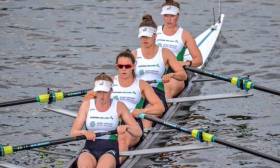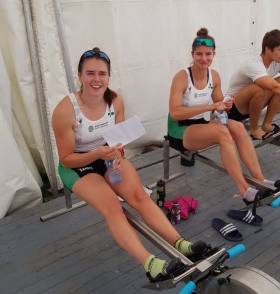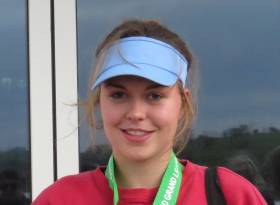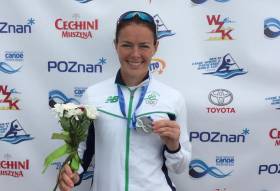Displaying items by tag: Poznan
Ireland Four To Compete in B Final at World Cup Rowing
#Rowing: The Ireland women’s four are set for a B Final on Sunday after finishing sixth in their semi-final at the World Cup Regatta in Poznan. Australia beat the United States One crew after an exciting contest in this semi-final, with China producing good finish speed to take third – and a place in the A Final – from New Zealand.
Ireland’s crew of Tara Hanlon, Monika Dukarska, Aileen Crowley and Emily Hegarty were fifth at halfway, over a length off the top-four, and finished behind Britain Two, who took fifth.
World Cup Regatta, Poznan, Poland – Day Two (Irish interest)
Women
Four – Semi-Final One (First Three to A Final; rest to B Final): 1 Australia 6:54.54, 2 United States One 6:55.52, 3 China 6:55.87; 6 Ireland (T Hanlon, M Dukarska, A Crowley, E Hegarty) 7:08.16.
Pair – Semi-Final One (First Three to A Final; rest to B Final): 1 New Zealand 7:32.18, 2 Italy One 7:35.99, 3 China One 7:36.43; 6 Ireland (C Feerick, E Lambe) 7:51.17.
#Rowing: Ireland’s Eimear Lambe and Claire Feerick took sixth place in their semi-final of the women’s pair at the World Cup in Poznan, Poland, this morning. They will take a place in the B Final.
New Zealand’s Kerri Gowler and Grace Prendergast, who hold the world’s best time, took control early on and won well. China One took second and Italy One beat the United States Two to the crucial third place, and qualification for the A Final.
World Cup Regatta, Poznan, Poland – Day Two (Irish interest)
Women
Pair – Semi-Final One (First Three to A Final; rest to B Final): 1 New Zealand 7:32.18, 2 Italy One 7:35.99, 3 China One 7:36.43; 6 Ireland (C Feerick, E Lambe) 7:51.17.
Ireland Women's Four Finish Well and Nail Semi-Final Place
#Rowing: Ireland’s women’s four joined the women’s pair in the semi-finals of the World Cup regatta in Poland. The top three crews from the fours repechage qualified, but Ireland sat fifth at halfway. Canada moved away and opened a small lead; Ireland sat fourth with 500 metres to go. Croatia, Ireland and Britain Two finished best to take the top three places.
World Cup Regatta, Poznan, Poland, Day One (Irish interest)
Women
Four
Heat One (First Three to A/B Semi-Finals; rest to Repechage): 1 Australia 6:32.50, 2 United States Two 6:33.57, 3 Britain 6:35.69; 4 Ireland (T Hanlon, M Dukarska, A Crowley, E Hegarty) 6:38.44. Repechage (First Three to A/B Semi-Final; rest to C Final):
1 Croatia 6:47.12, 2 Ireland 6:47.49, 3 Britain Two 6:48.19.
Pair
Heat Two (Winner to A/B Semi-Final; rest to Repechages): 1 Italy Two 7:07.10; 2 China Two 7:09.55, 3 Ireland (E Lambe, C Feerick) 7:10.31. Repechage One (First Two to A/B Semi-Final; next two to C Final; rest to D Final): 1 United States One 7:15.35, 2 Ireland 7:19.33; 3 Canada One 7:26.52.
#Rowing: Ireland’s women’s pair of Claire Feerick and Eimear Lambe qualified for the semi-final at the World Cup Regatta in Poznan, Poland. The young crew took a clear second place behind Megan Kalmoe and Tracey Eisser of the United States in their repechage. The USA One crew were clear winners, while Feerick and Lambe did well to win a battle with Canada One to claim the second – and final – qualifying spot.
World Cup Regatta, Poznan, Poland, Day One (Irish interest)
Women
Four
Heat One (First Three to A/B Semi-Finals; rest to Repechage): 1 Australia 6:32.50, 2 United States Two 6:33.57, 3 Britain 6:35.69; 4 Ireland (T Hanlon, M Dukarska, A Crowley, E Hegarty) 6:38.44.
Pair
Heat Two (Winner to A/B Semi-Final; rest to Repechages): 1 Italy Two 7:07.10; 2 China Two 7:09.55, 3 Ireland (E Lambe, C Feerick) 7:10.31. Repechage One (First Two to A/B Semi-Final; next two to C Final; rest to D Final): 1 United States One 7:15.35, 2 Ireland 7:19.33; 3 Canada One 7:26.52.
#Rowing: Ireland’s Claire Feerick and Eimear Lambe finished third in their heat of the women’s pair at the World Cup Regatta in Poznan in Poland this morning.
To qualify directly for the semi-finals, the Ireland crew would have had to win this heat and Feerick and Lambe were at or near the head of the field throughout the race. They were marginal leaders through the 1,000 metres and the 1500 metres, after which China Two took over. Italy Two passed them coming up to the line to take top spot.
Feerick and Lambe will compete in a repechage with the aim of taking this route to the A/B semi-finals.
World Cup Regatta, Poznan, Poland, Day One (Irish interest)
Women
Pair
Heat Two (Winner to A/B Semi-Final; rest to Repechages): 1 Italy Two 7:07.10; 2 China Two 7:09.55, 3 Ireland (E Lambe, C Feerick) 7:10.31.
Silver Medal for Jenny Egan at World Cup in Poznan
#Canoeing: Ireland’s Jenny Egan had another podium finish at a World Cup today. She took silver in the K1 5,000 in Poznan in Poland. Egan and Inna Hryshchun on the Ukraine broke clear of the rest of the field after the second portage. The two disputed the gold and silver placings, with Egan missing out by just over half a second.
Barry Watkins took seventh in the men’s K1 5000, while Ronan Foley took 14th.
Canoe Sprint World Cup, Poznan, Poland (Irish interest)
Saturday
Men
K1 1,000 – B Final (Places 10 to 18): 8 Barry Watkins
K1 500 – B Final (Places 10 to 18): 8 Watkins.
Women
K1 200m – Semi-Final Three (7-9 to C Final): 7 Jenny Egan. C Final (Places 19 to 27): 5 Egan
Paracanoeing: VL3 Men’s 200m – Semi-Final One: 3 Patrick O’Leary. KL3 Semi-Final: 4 O’Leary
Sunday
Men
K1 5,000 – Final: 7 Watkins, 14 Ronan Foley.
Women
K1 5,000 – Final: 1 Ukraine 25:31.548, 2 Ireland (Egan) 25:32.112, 3 Slovakia 25:51.496.
#Rowing: Jake and Fintan McCarthy raced brilliantly to win their heat and qualify directly for the A/B Semi-Finals at the World Under-23 Rowing Championships in Poland this morning. There was just one direct qualification place on offer in this heat of the lightweight double sculls and Italy gave Ireland quite a race. The two crews were locked together as they approached the 1500-metre mark – but then the McCarthy twins went. They led by .18 of a second at 1500 metres and sprinted away from their rivals to win well.
Lydia Heaphy and Margaret Cremen made a solid start to their campaign in the women’s lightweight double by taking the second and final qualification spot in their heat. They were fastest to the 500 metre mark, but Britain’s Susannah Duncan and Danielle Semple took over from there. They would build their lead to win by almost eight seconds. Cremen and Heaphy secured their spot, staying well clear of third-placed Poland.
World Under-23 Championships, Poznan, Poland (Irish interest; selected results)
Men
Lightweight Double Sculls – Heat Three (First to A/B Semi-Finals; rest to Repechage): 1 Ireland (F McCarthy, J McCarthy) 6:35.94.
Women
Lightweight Double Sculls – Heat Four (First Two to A/B Semi-Finals; rest to Repechage): 2 Ireland (L Heaphy, M Cremen) 7:37.99.
O'Donovans Sprint to Silver at World Cup Rowing
#Rowing: Paul O’Donovan and Gary O’Donovan took a silver medal at the World Cup Regatta in Poland this morning. The Ireland lightweight double took second in an exciting race. France led from early on and were never headed. Ireland came from sixth to hold second by 1500 metres – but coming up to the line they came under severe pressure from China and Poland, who took the bronze.
World Cup Regatta, Poznan, Poland, Day Three (Selected results; Irish interest)
Men
Lightweight Double Sculls – A Final: 1 France (P Houin, J Azou) 6:12.40, 2 Ireland (G O’Donovan, P O’Donovan) 6:15.33, 3 Poland (J Kowalski, M Janknowski) 6:15.90; 4 China One 6:16.17, 5 Germany 6:17.67, 6 Japan Two 6:17.99.
Women
Pair – B Final: 1 United States 7:22.54, 2 Ireland (A Keogh, A Crowley) 7:30.09.
Single Sculls – B Final: 1 Ireland One (S Puspure) 7:28.79, 2 United States Two (M O’Leary) 7:29.35, 3 Ireland Two (M Dukarska) 7:32.34; 4 Germany Two 7:36.36, 5 United States One 7:37.43, 6 Austria Two 7:40.21.
Puspure Wins Battle of the Ireland Crews at Poznan
#Rowing: Sanita Puspure won the B Final of the women’s single sculls at the World Cup Regatta in Poznan today. The focus may have been on the battle between Puspure and Monika Dukarska, but Puspure’s main challenger down the course was Megan O’Leary of the United States. She finished a close-up second, with Dukarska third, 3.55 seconds behind her Ireland team-mate.
In the B Final of the women’s pair, the new crew of Aifric Keogh and Aileen Crowley started well but had to give way to the more accomplished United States crew of Kathrin Roach and Sophia Vitas, who took eighth overall.
World Cup Regatta, Poznan, Poland, Day Three (Selected results; Irish interest)
Women
Pair – B Final: 1 United States 7:22.54, 2 Ireland (A Keogh, A Crowley) 7:30.09.
Single Sculls – B Final: 1 Ireland One (S Puspure) 7:28.79, 2 United States Two (M O’Leary) 7:29.35, 3 Ireland Two (M Dukarska) 7:32.34; 4 Germany Two 7:36.36, 5 United States One 7:37.43, 6 Austria Two 7:40.21.
Gold for O'Donovan and O'Driscoll at World Cup Rowing
#Rowing: Ireland’s Mark O’Donovan and Shane O’Driscoll resisted a strong challenge by Britain to take gold in the lightweight pair at the World Cup Regatta in Poznan, Poland.
The Irish started well and led through halfway and the 1500 metres mark. Britain’s Sam Scrimgeour and Joel Cassells kept the pressure on and lost by under a length. Brazil took bronze in this three-boat race.
World Cup Regatta, Poznan, Day Two (Irish interest; selected results)
Men
Lightweight Pair – Final: 1 Ireland (M O’Donovan, S O’Driscoll) 6:32.93, 2 Britain (J Cassells, S Scrimgeour) 6:34.17, 3 Brazil 6:37.21.
Women
Pair – Repechage (First Four to A Final; rest to B Final): Australia 7:15.41, 2 New Zealand 7:16.26, 3 Chile 7:17.86, 4 Britain 7:22.94; 5 United States Two 7:28.76, 6 Ireland (A Keogh, A Crowley) 7:35.93.
Single Sculls – Semi-Finals (First Three to A Final; rest to B Final)
Semi-Final One: 1 Austria (M Lobnig) 7:29.08, 2 China (J Duan) 7:31.25, 3 New Zealand (H Osborne) 7:32.80; 4 Ireland One (S Puspure) 7:35.99, 5 Austria Two 7:42.16, 6 Germany Two 7:49.93.
Semi-Final Two: 1 Britain (V Thornley) 7:29.58, 2 Germany (A Thiele) 7:33.43, 3 Ukraine (D Dymchenko) 7:35.50; 4 Ireland Two (M Dukarska) 7:37.19, 5 United States One 7:38.05, 6 United States Two 7:42.84.
Lightweight Single Sculls – Semi-Finals (Three to A Final; rest to B Final) – Semi-Final One: 1 New Zealand 7:44.06, 2 Poland 7:45.45, 3 Switzerland 7:48.27.
Semi-Final Two: 1 Sweden (E Fredh) 7:40.68, 2 United States (M Jones) 7:41.38, 3 Ireland (D Walsh) 7:42.79; 4 Russia 7:44.47, 5 Netherlands 7:51.60, 6 Austria 7:58.54.
A Final: 1 New Zealand 7:36.89, 2 Poland 7:37.19, 3 Switzerland 7:37.20; 4 Sweden 7:37.75, 5 United States 7:43.07, 6 Ireland (Walsh) 7:48.91.


































































